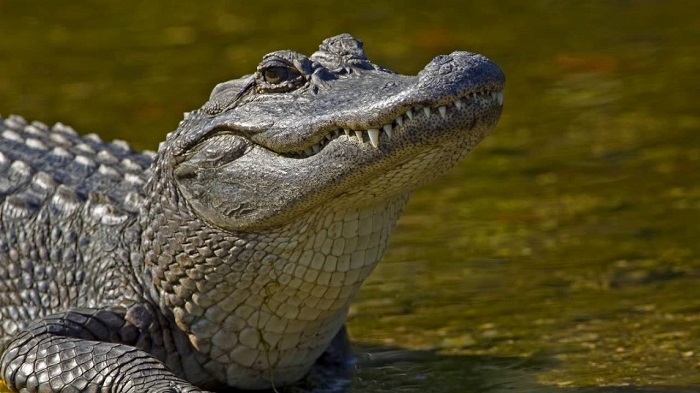Gators
Basics

Alligators are large reptiles, members of the order Crocodylia. Alligators and crocodiles are, therefore, closely related.
An alligator is distinguished by its wide, rounded snout and black color. Also, all of its upper teeth can still be seen when its mouth is closed.
They are large animals with powerful tails that are used both in defense and in swimming. Their eyes, ears, and nostrils are placed on top of their long head and project slightly above the water when the reptiles float at the surface, as they often do.
The average life span of alligators is about 50 years in the wild. However, there have been reports of some specimens living beyond 70 years of age in captivity.
Behavior
Alligators are social creatures and often stay in groups called congregations. These groups are typically seen basking in the sun or taking a swim. This is because alligators can't control their temperature internally. So, when they are cold, they sunbathe, and when they are hot, they go for a swim.
Alligators also use water to hunt. On land they are awkward, but in the water they can swim very quickly using their tails. This makes it easier for them to catch prey. American alligators can swim up to 20 mph (32.18 km/h) and run on land as fast as 11 mph (17.7 km/h), according to the San Diego Zoo.
Members of both sexes hiss and the males also give loud roars that carry over considerable distances. During the breeding season, the female builds a mound nest of detritus and vegetation in which she buries about 20 to 70 hard-shelled eggs. She guards the eggs and may at this time be dangerous. They commonly dig burrows in which they rest and avoid weather extremes.
Though many people are afraid of alligators, these animals keep to themselves and usually don't attack humans unless they are threatened.
Size
The American alligator can grow up to 11.2 feet (3.4 meters) long and weight nearly half a ton (1,000 lbs. or 454 kilograms), according to the Smithsonian National Zoological Park.
Habitat
The American alligator lives in the southern United States, from North Carolina to Texas, according to the Smithsonian Zoo. These gators can be found in slow-moving rivers, ponds, lakes, and swamps.
Diet
Alligators aren't picky about what they eat and have a huge appetite. They are carnivores, so any type of prey is a meal to these reptiles. Alligators may eat fish, mollusks, birds, small mammals, and other reptiles. Though carnivores usually only eat meat, alligators will also munch on fruit. They may sometimes take prey as large as deer or cattle.
Other
- The alligator's rough skin makes it look like a floating log, which is helpful when stalking prey.
- Although alligator attacks are rare, they are three times as deadly as shark attacks
- In Florida, which has the highest number of human-alligator interactions, there have been 24 deadly alligator attacks since 1948, with the majority coming in the past 20 years.
- Alligators have extraordinary hearing allowing them to accurately pinpoint the source of sounds.
- Alligator bites pack force equal to the weight of a small pickup truck. Studies have documented alligator bites that have nearly 3,000 pounds of force, which is one of the most powerful bites ever recorded from a living animal.
- Juvenile gators are capable of eating nearly a fourth of their body weight in one sitting. For comparison, that's equivalent to a 200-pound human eating 50 pounds worth of steak (or whatever dish you prefer) for dinner